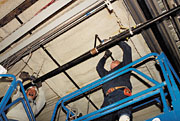Accessible from the south via Eureka Rd. or from the north via Interstate 94, the terminal will cost approximately $1.2 billion and is scheduled to open some time in December 2001.
In order to fulfill the mechanical installation for this huge project, three competitors joined under the title of C.P.G., LLC. The “C” is for Stanley Carter, Farmington, MI; “P” is for Pace Mechanical, Westland, MI; and “G” is for John E. Green, Highland Park, MI.
According to Don Van Sickle, plumbing general foreman for Pace Mechanical, “the T-shaped building is based on two airports, one in Belgium and one in Japan. Believe me, it did not start out as much more than bulldozers and dirt. The kind of work that goes into a project like this one is amazing.”
But upon visiting the terminal a few weeks ago, it was evident that much progress has been made.

Building A Powerhouse
Wayne County, the owner of the airport, and Northwest Airlines, which is responsible for overall construction of the terminal, decided to go to a third party to supply its energy needs.In order to complete what is called the “power house,” which will house all of the boilers and chiller units, the county and Northwest chose to create a joint venture between MCN Energy, Detroit, MI, and DQE Energy Services, Pittsburgh, PA, called Metro Energy LLC. Metro Energy later retained Pipe Systems, Inc., Troy, MI, as its principal installation contractor.
Larry Toth, general manager of Metro Energy, said that these partners would be responsible for the power plant’s construction and operation needs over the next 30 years.
Toth expounded upon the four components that will make up the power plant, “the first of which is the hot water generators, or boilers.” Involving three generators, manufactured by International Boiler Works (IBW), Toth said Lipten, a manufacturer representative that sells and services boilers (located in Detroit), supplied the units.
“Each generator has a 37.5-MBtuh capacity, and all of the heating will be provided through these generators coupled with three hot water recovery units,” Toth said.
The second component of the power plant is the chilled water units. Toth said that there are seven chillers manufactured by The Trane Company, La Crosse, WI, with a total combined capacity of 9,200 tons.
The on-site electrical generator, which Toth refers to as the third component, consists of three 5.7-MW spark-ignited, natural gas-fired engines. Each engine, manufactured by Wartsila of Vaasa, Finland, has a heat recovery hot water generator with a capacity of 9 MMBtuh each.
The electricity is being supplied on the local grid by Detroit Edison. “With this configuration, we are able to not only buy the energy needed to run the terminals, but depending on the economic or electric situation, we can also make our own energy,” said Toth.

More Than Numbers
According to Van Sickle, the terminal is set to house the second-largest airport mall in the United States, next only to Miami Airport in Miami, FL, along with various restaurants, snack food vendors, and the normal airport shop.There are two concourses within this new terminal — East and West.
The East Concourse is the larger of the two. It will sport an array of necessities meant to make travelers more comfortable while traveling.
Containing 31 shops and restaurants, utilizing 2,200 ft of dual-moving walkways, the East Concourse will have two 6,800-sq-ft WorldClubs accessible to Northwest WorldPerks Elite members.
In addition, an automated people mover, used in many new airports around the country, has been installed, and will take passengers a length of 3,600 ft throughout the concourse. The total length of this terminal is 6,900 ft. It has 66 gates, including 10 international gates.
The West Concourse is actually a satellite concourse holding 33 gates, including eight jet gates and 25 commuter gates. It will also house 11 shops, food concessions, and a 3,200-sq-ft WorldClub.
But there’s more. Van Sickle said the plumbing/piping contract calls for:
The 3.9 million-sq-ft parking structure, built specifically for this terminal, features 11,500 parking spaces on 10 levels. Including two luggage check-in stations, a waiting enclosure, moving walkways, glass-backed elevators, a pedestrian bridge, and restrooms, the parking structure is small in comparison to the size of the terminal going up along side it.
Already, Metro Airport has the distinction of being the world’s sixth busiest airport. With more than 1,500 daily takeoffs and 20 carriers landing, the airport serves more than 130 domestic and international nonstop destinations.
For more information, visit www.metroairport.com (website).
Publication date: 04/09/2001 Web date: 06/18/2001

Report Abusive Comment